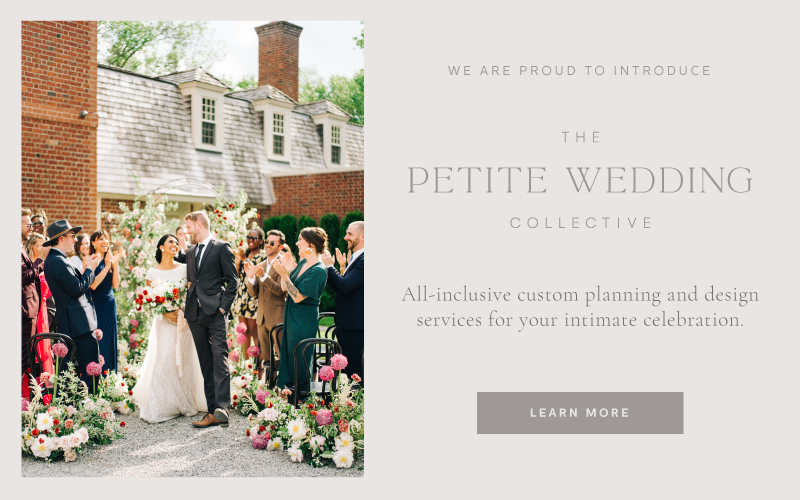Your invitations are the first experience guests have with your event, so make it count! Here are some FAQs answered to set you up for success.
What are the common components of a full “invitation suite”?
– Outer envelope
– Inner Envelope (optional for less-formal invitations)
– Invitation
– Details // Reception Card
– RSVP Card – we discourage postcards; while they can seem to be less expensive than their enveloped
– RSVP Envelope – pre-addressed with stamp
– Design additions: (optional: wraps, wax seals, envelope liners, non-paper materials, etc.)
When should we send out the invitations?
Technically, invites should be sent 6-8 weeks prior to your event date, but we recommend sending them 8-12 weeks out for a few reasons. First, if you have the dreaded “B List” invitees, you may still be able to get them an invitation within the appropriate 6-8 week window if you’ve started to receive some declined invites. (You should never send an invite closer than 6 weeks out). Second, it gives you more lead time should you encounter any issues with lost mail. And last, you can set an earlier RSVP date while still giving your guests ample time to respond.
What should my RSVP date be?
Double check all of your vendor contracts for when they require final numbers be sent to them (the venue, caterer, florist and a few others will likely contractually require this information). For example, if your earliest vendor deadline is 3 weeks prior to the wedding, set your RSVP date for 4 weeks prior. This will give you time to track down any stragglers and get organized.
How many extra invitations should I order?
We recommend ordering 15 extra invitations. This gives you some leeway for the possibility of any additional invitees, issues with the postal services and two clean full invite suites to give to your photographer for detail shots. If you are planning to use a calligrapher for addressing your invitations, check with them about their policies regarding extra envelopes. Many calligraphers ask for 10-20% more envelopes to leave room for error.
Where do we put registry information?
Registry information should not be included anywhere on your physical paper goods. Instead, direct your guests to a wedding website for more information and include it there.
Should we list a dress code?
Listing a dress code is not required but can be helpful. If you don’t list one, and your venue and cultural background assume a fairly standard western-vibe, your guests will likely arrive in “cocktail attire.” If you are requesting a more specific look, it’s best to specify on the invitation itself. See our article about “Dress Codes Defined” for more details.
How do I address them?
Depending on the formality and design aesthetic of your event, the traditionality of your envelope addressing may vary. See our article on “Addressing Invites” for more details.
Do you have any examples of actual invitation wording?
Yes! See our article on “Sample Invitation Wording” for examples.
Can I use abbreviations?
Don’t use abbreviations, symbols or middle initials. Literally write things out like, “California” instead of “CA” and “Street” instead of “St.”
How do I ensure guests RSVP correctly and on time?
The joys of collecting RSVPs are still ahead! You will likely have some stragglers and folks you need to track down. We recommend building in buffer time with your RSVP date so you have a few days to a week before you actually need to get final numbers to vendors to do this. Depending on who the specific invitees are that have yet to respond, consider delegating the task of following up to the person closest to them. For example, if it’s your mom’s business partner who hasn’t yet replied, ask her to be the one to follow up.
What if I get an RSVP card back with no name on it?
We recommend using a light pencil to number the back of each RSVP card that corresponds to that invitee’s position on your master guest list (if “John Smith” is on line 2 of you excel spreadsheet, put a number “2” on the corner of the RSVP card going in his envelope). That way, if someone sends the card back in without their name (you’d be shocked how common this is) you know who it is from.
Who gets a plus one?
Spouse of attendees should always be invited. When it comes to your friend’s significant others or dates, to add or not add a plus one can be a tough question. Use your discretion depending on your budget and how long the couple has been together (six months is a good gauge). If you are inviting someone with a plus one, try to find out the name and address of his or her date and send two separate invites. If that’s not possible (or you prefer to send one), address the outside envelope to the primary invitee, with the inside envelope reading “Ms. Holly Hart and Guest.” If you know whom he or she is bringing, it’s more personal to include that person’s name on a separate line of the outer envelope.

